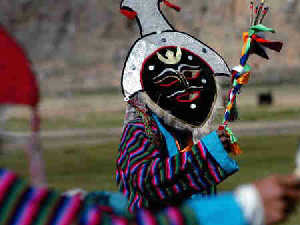 During the reign of the fifth Dalai Lama in the 17th century, this performing art was separated from religious rituals and became an independent dramatic form. What started off as pantomime evolved into a structured art of song, dance, chants, and narration, accompanied by flamboyant masks. Story lines included the nation's history, ancient legends of heroes and gods, and satires on current events. The tradition was passed down from one generation to the next, developing into Tibetan Opera, which was popularized throughout the region.
During the reign of the fifth Dalai Lama in the 17th century, this performing art was separated from religious rituals and became an independent dramatic form. What started off as pantomime evolved into a structured art of song, dance, chants, and narration, accompanied by flamboyant masks. Story lines included the nation's history, ancient legends of heroes and gods, and satires on current events. The tradition was passed down from one generation to the next, developing into Tibetan Opera, which was popularized throughout the region.
As the opera matured it became increasingly complex in structure, containing many literary strands, with very beautiful story depictions. Over time the opera also absorbed many local dances and other art forms and now, there is always a light-hearted humor in it that appeals to audiences.
 Lavish, flamboyant, and over the top
Lavish, flamboyant, and over the top
Traditionally, the theater for Tibetan Opera was an open circular space sheltered by a canopy, with the stage defined by a magical circle and centralaltar.
Over the centuries, the opera has formed a three-part stage process.
In the prelude, known as wenbadun, Wenba men in blue masks, two Jialu men, and several fairies take the stage to perform religious rituals and songs and dances, and introduce the actors and actresses.
Next, a narrator explains the plot, section by section, as the opera is being performed, episode by episode. In the absence of a realistic setting and props, the narrator's words must conjure up the stage effects in the audience's imagination. Two musicians -- a drummer and a cymbalist -- sit on the side of the stage. An idiosyncratic drumbeat, accompanied by a specific dance step, identifies each character.
The performance ends with a blessing ritual that features a blessing ceremony and is also an occasion for the audience to present hada and donations.
Tibetan Opera costumes are very lavish, with rich brocades and a striking variety of masks and animal motifs. The musical score is created entirely by the drum and cymbals that punctuate every movement, and by the singing actors. The rapidly chanted narration alternates with the sung dialogues repeated in the chorus. The dance movements are refined, exaggerated, and vigorous.
The highlight of Tibetan Opera is the mask. Located on the front of the mask is usually a motif, such as the sun or moon. The actor's role can be identified from the type of mask he or she is wearing. For example, a red mask represents the king; a green, the queen; a yellow, Lamas and deities, and so on.
Tibetan Opera call for skills in singing, dancing, elocution, and the martial arts. Historical pageantry, myth, and magic are woven together with earthly humor and scenes from the daily lives of ordinary people. The primitive simplicity and vigor demonstrated in the singing and dancing is effectively reflected in the typical Tibetan landscape backdrops.
Today, changes have taken place in the structure, singing, dancing, masks, and stage format of Tibetan Opera; an orchestra, backdrop, lighting, and make-up have also been added. Tibetan opera is now also performed both in the open air and indoors.
